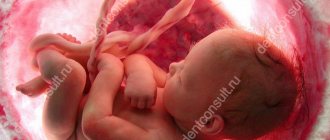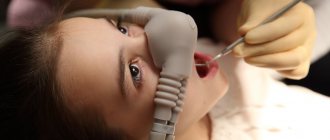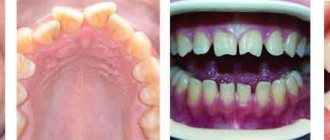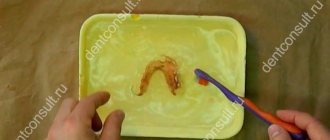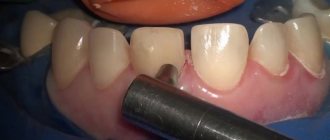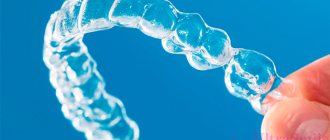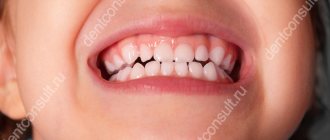1072
Among the various methods of modern dentistry used to solve problems with dentition defects, the installation of microprostheses rightfully deserves the attention of patients. The products help restore the functionality and aesthetics of the dentofacial apparatus.
A wide selection of microprostheses of domestic and foreign production allows you to restore damaged or missing teeth, in accordance with preferences, wishes, personal experience, and financial capabilities.
General overview
The microprosthetics technique is a convenient, effective way to hide defects and restore chewing functions in the absence of several units in the dentition. The goal of the method is to restore elements of the dentition with minimal damage to the hard tissues of the teeth.
The modern method of aesthetic dentistry is ideal for patients who have a negative attitude towards the preparation procedure that is necessarily carried out during classical prosthetics.
The list of materials used in the manufacture of orthopedic devices to restore the shape, color shade of partially damaged teeth or their complete loss includes:
- metal ceramics , which ensures the aesthetics and durability of products;
- nylon , the distinctive characteristics of which include hypoallergenicity and flexibility;
- porcelain and zirconium dioxide , which provides the opportunity to provide excellent aesthetics and strength of orthopedic structures;
- metal alloys based on Pd (Palladium), Au (gold) , combining strength, durability, and ductility;
- composite materials , with the help of which it is possible to restore fragments in hard-to-reach places.
Design of dental microprostheses
In our dentistry in Saratov “Flart” you can install removable dental microprostheses.
One or more artificial teeth on a base made of acrylic or nylon are attached to adjacent teeth using a gentle method - using “wings” - clasps that tightly cover the bases of adjacent teeth, without causing harm to them, but perfectly fixing the prosthesis itself.
For such an interesting structure, removable microprostheses are called “butterflies”. They are easy to take off, easy to put on, and easy to care for.
Indications and contraindications
Microprosthetics are indicated in a number of cases. These include:
- increased abrasion of enamel, which leads to a decrease in the protection of teeth from the destructive effects of aggressive environments and mechanical stress during chewing food;
- severe destruction of the supragingival part of the tooth, resulting from the lack of timely treatment of caries, demineralization of enamel, lack of calcium in the body of patients;
- absence of one or more elements;
- presence of chips, scratches, cracks;
- excessive mobility of the bone organs of the oral cavity;
- darkening of the enamel due to previous diseases;
- the desire to acquire an attractive smile, improve the shape and color of the enamel.
Timely seeking help from a dentist allows you to prevent severe destruction of dentition units and eliminate the need for classical prosthetics associated with depulpation of supporting elements.
The installation of orthopedic systems to replace completely destroyed fragments and restore their shape and color is not recommended:
- with an extended carious process;
- in case of inability to carry out high-quality hygiene procedures;
- inability to ensure dry surfaces of teeth requiring microprosthetics.
When cavities of small depth are identified, dentists recommend filling them.
Indications for microprosthetics
There are several indications for microprosthetics:
- pathological abrasion of teeth;
- destruction of the crown - as a result of caries, trauma, which is especially in demand in cases where it is impossible to classically restore the crown with filling materials;
- complete destruction of the crown, saving only the tooth root - in this case, pins can be used to fix an artificial crown;
- missing tooth - the choice of prosthetic method in this case depends on the structure of the jaw, which tooth is missing and what caused its removal/loss;
- chips, cracks in enamel, darkening or inability to whiten yellow enamel - these indications apply to the installation of veneers.
Kinds
Orthodontic dentistry offers a wide selection of microprostheses for hiding and eliminating defects of bone organs in the oral cavity. Let's look at popular designs in more detail.
Adhesive bridges
It is planned to install fiberglass bridge systems to replace 1-2 elements.
Beams with prostheses are attached to the supporting units . The designs allow installation without turning the supporting elements.
Formed artificial teeth from light-polymerizing material are attractive due to their low cost.
Veneers and Lumineers
The products are overlays in the form of thin plates made of ceramics or composite materials. Their thickness varies from 0.2 mm to 1.5 mm. Attached to the outer surface of the tooth.
The use of ceramic and composite onlays involves minimal processing of bone organs and provides reliable protection from destruction.
Very thin layers are called lumineers. They are installed without grinding and allow you to create the charming smile that many Hollywood stars demonstrate.
Ceramic veneers are used to restore teeth, eliminate chips, unsightly shapes, and problems with occlusion. Composite overlays provide the opportunity to get rid of single defects in the form of cracks and stains on the enamel.
Tabs
The products are designed to restore severely damaged fragments, the chewing surface, as well as correct the shape and color.
They can be made from ceramics and cermets, composite materials, gold, alloys of silver with palladium, chromium with cobalt.
Pins
Microprosthetics using pins is intended to restore the supragingival part of a tooth destroyed under the influence of negative external factors.
Grinding of adjacent dentition units is not required. An artificial tooth crown is formed on the basis of a pin installed in its root part .
Butterflies
The use of nylon butterfly systems is recommended for the restoration of lost elements before the installation of fixed dentures.
The design has the shape of natural organs with special hooks in the form of wings. With their help, butterflies are attached to adjacent units without preliminary turning them.
CBW
CBW systems provide the opportunity to perform microprosthetics using a crownless bridge method.
They have proven themselves to be excellent in the restoration of anterior teeth and their analogues that perform a chewing function.
Features of the production of Cerec veneers and the material used for production.
Come here to find out what designs are used to relieve patients from completely edentulous teeth.
This address https://www.vash-dentist.ru/protezirovanie/semnyie-p/balochnyiy-na-implantatah.html provides detailed information about the advantages and disadvantages of beam dentures on implants.
Types of microprosthetics
This method of eliminating tooth or dentition defects consists of several types of prosthetics:
Adhesive
. Microprosthetics of a missing tooth are often performed using this method. In this case, the artificial tooth is fixed in place of the removed or fallen tooth with the help of supporting teeth - the use of inlays and onlays is assumed. Grinding of teeth is not implied here at all or is carried out in gentle ways. The advantage of this type in comparison with classical prosthetics is the preservation of most of the tissues of healthy teeth.
This method is indicated in cases where there is an allergic reaction to metal elements of dentures. It is worth noting that it can also be used as a temporary measure.
The artificial tooth can rest on inlays installed in adjacent teeth. If they have old fillings, the doctor simply replaces them with newly made inlays. If there are no old fillings in the teeth, the doctor creates a cavity in it, into which the inlay is installed. The artificial tooth subsequently rests on it. Creating a cavity does not imply removing the pulp - the tooth remains “alive”. The amount of tissue removed is insignificant, in contrast to classical turning. The procedure eliminates the loss of your own tissues completely if the tooth has already been filled in advance - only the material is replaced.
Inlays and overlays
. These microprostheses are manufactured in a dental laboratory using ceramic compounds. Tooth restoration is carried out in a similar way to a filling - pre-fabricated elements are installed in the tooth cavity using filling materials, as a rule, we are talking about liquid light-curing composites. The advantages of this type of microprosthetics are the precision of fitting the prosthesis to the individual parameters of the tooth cavity, the full correspondence of their properties (in terms of functionality and aesthetics) to the tooth’s own hard tissues. The inlay is a filling made in advance in the laboratory from durable and aesthetic material. The onlay is a relatively larger microprosthesis. The main indication for their use is the need to restore the shape and function of the chewing part of the teeth.
Veneers.
This type of microprosthetics is designed to hide tooth defects - chips, cracks, diastemas (gaps between teeth), slight curvature, scratches. Veneers can also be used if the shade of tooth enamel is unsatisfactory. Of course, they are more often used for the front teeth - noticeable when talking and smiling, their main function is to give aesthetics to the teeth.
Veneers are thin ceramic shells that are bonded to the outside of teeth. They are widely used in cases where other aesthetic dentistry procedures do not bring the desired result. Installation involves grinding off the top layer of enamel.
Lumineers
- a type of microprosthesis with an even smaller thickness (less than 0.3 mm). Their installation involves grinding down a smaller amount of tooth enamel, and in some cases this procedure can be avoided altogether.
Butterfly
. This design is installed mainly in adolescence, during the formation of permanent teeth. It is an element made of nylon; it serves as a microprosthesis for one or two teeth. Installation does not imply grinding of adjacent teeth.
Classification by installation method is not the only one. Microprostheses are also divided into types according to other characteristics: the method of transmitting the chewing load, the typography of the row defect, the material and manufacturing technology.
Installation steps
Fixation of microprostheses involves performing certain stages. Their list includes:
- treatment of decaying teeth, elimination of carious lesions;
- installation of temporary filling materials in the formed cavities;
- taking impressions;
- production of microprostheses in laboratory conditions;
- installation of an orthopedic structure;
- providing recommendations for the care of microprostheses.
Installation of veneers and lumineers
Restoring teeth using veneers begins with treating pathologies of the elements, choosing the color and shape of the veneer. They are made in a laboratory after the impression is taken.
To prepare the tooth surface for their installation, grinding is performed to a depth corresponding to the thickness of the orthopedic device.
During the production of the veneer, a temporary structure is used to protect the enamel.
After making the onlay in the dentist’s office, it is tried on and assessed for accuracy of fit and compliance with the chosen shape and color. The veneer is then attached to the enamel using an adhesive.
Subsequent polishing of the surface of the lining makes it possible to hide the fixing seams. When installing lumineers, the stage of grinding down tooth enamel is eliminated.
After hygienic professional cleaning, the thinnest pads are installed in place. The adhesive composition ensures their reliable fixation to the tooth surface.
Creation of an adhesive prosthesis
Adhesive prostheses allow you to restore no more than 2 units and are installed within three hours.
The main element of fastening structures are wire or fiberglass beams, which are installed on the supporting teeth.
On them, the dentist forms future crowns from the composite. The absence of the need to manufacture metal bases makes it possible to reduce the time required for microprosthetics.
To fix adhesive bridges, special dental glue is used.
Installing a tab
Microprosthetics based on inlays are carried out in several stages. After radiography and treatment of oral pathologies, impressions are made. They are sent to the laboratory.
While the orthopedic device is being manufactured, a temporary inlay is placed in the patient's mouth.
After receiving the microprosthesis and removing the temporary device, the permanent structure is fixed under local anesthesia.
The use of cement or adhesive compositions ensures reliable adhesion to the hard tissues of the tooth. The sanding procedure completes the inlay installation process.
From the video, learn about the purpose and installation of a ceramic inlay.
Pins
Dental pins refer to orthopedic devices that look like rods and are installed in root canals.
The outer part is intended for restoring a dental crown. The reliability of the installation is checked the next day.
After completion of the rehabilitation period, the prosthesis is installed on the pin, first on a temporary and then on a permanent basis.
CBW dentures
Installation of CBW systems involves high-quality fastening of titanium or zirconium dioxide locks in abutment teeth.
For these purposes, special holes are made with a diameter of 1-1.2 mm to a depth of 1.6-1.8 mm. After installing the locks, an impression is made, and prostheses with built-in lock elements are made.
Then the finished devices are fixed with cement on both parts of the lock, polymerization and subsequent polishing of the structure are carried out. The video provides additional information about crownless prosthetics.
Immediate butterfly prostheses
Nylon butterfly prostheses are removable orthopedic devices. The use of clasps, which are plastic hooks, ensures reliable fixation of devices on supports. Removable structures are easily inserted and removed from the mouth.
In what cases is it justified to use a removable laminar denture in case of partial absence of teeth and what is the service life of the product?
This material is dedicated to the Bredent clasp prosthesis.
Here https://www.vash-dentist.ru/protezirovanie/semnyie-p/silikonovyih.html we will tell you how much silicone dentures cost.
Stages of microprosthetics
The microprosthetics procedure involves two main stages:
- The doctor treats the decaying tooth - removes tissue softened by caries, prepares the tooth for further prosthetics, and places a temporary filling in the tooth cavity. This stage also involves the creation of a tooth impression, from which a microprosthesis will subsequently be made in a dental laboratory. This allows you to take into account individual parameters and create a design that exactly fits the tooth cavity.
- The specialist installs the finished inlay/onlay into the tooth cavity or on its surface, ensuring reliable fixation using adhesive materials (composite cements). This allows the cavity to be filled hermetically and ensures reliable installation.
Advantages and disadvantages
Orthopedic devices are manufactured using high-tech modern equipment. Their advantages include:
- excellent quality of materials used in the production of microprostheses and eliminating the development of inflammatory processes in the oral cavity;
- ensuring reliable fixation;
- the ability to restore and correct the shape and color of teeth in a comfortable environment for the patient without the need for multiple visits to dental offices;
- obtaining a delightful smile and a natural appearance of the jaws;
- prevention of further tooth decay and the possibility of high-quality replacement in the absence of teeth;
- convenience and ease of care.
The relatively high cost of orthopedic devices is their only drawback.
Advantages of microprosthetics
Onlays and inlays are similar in appearance to the fillings familiar to most patients. However, these microprostheses have comparative advantages - high accuracy of fit according to a previously taken dental impression, high aesthetic and functional characteristics. Thus, the ceramic material used allows you to effectively restore a tooth that will be indistinguishable in appearance from your own teeth - this applies to shape, shade, and the degree of transparency of the enamel.
Microprosthetics is a very effective method of restoring a damaged tooth; it has especially proven itself when it is necessary to restore the front teeth.
Life time
The quality of the material and installation of microprostheses, as well as correct adherence to the dentist’s recommendations for their care, determines the service life of the structures:
- composite veneers – up to 5 years;
- ceramic onlays and lumineers – from 10 to 15 years;
- fiberglass bridges – 5 years;
- dental inlays – from 10 to 12 years;
- imediat butterfly prostheses – from 3 to 7 years;
- CBW dentures – from 5 to 10 years.
Care of microprostheses
It is necessary to brush teeth with inlays or veneers in the usual way, but it is better to avoid toothpastes with abrasives. After installing veneers, you will have to forget about teeth whitening procedures, but this is unlikely to be necessary - after all, these microprostheses are designed to improve the aesthetics of teeth.
It is very important to forget about a number of bad habits (such as biting your nails) - especially when it comes to installing veneers or lumineers. Otherwise, mechanical loads can lead to damage to microprostheses, and they will have to be replaced with new ones.
The use of dental floss and, if possible, an irrigator is advisable; the dentist will definitely explain the specifics of using these products to maintain hygiene.
Price
The cost of microprosthetics services varies widely. The quality, type of material used in the manufacture of structures, and the degree of tooth decay determine the prices for the installation of orthopedic devices.
Their range is:
- 5000 rubles for one tab;
- from 12,000 rubles for one veneer;
- 6000 rubles for adhesive prostheses;
- 40,000 rubles for mounting the CBW system;
- from 15,000 rubles for removable dentures - butterflies;
- from 6,000 rubles for microprosthetics with pins.
Advantages of dental microprostheses
In addition to ease of care and ease of manufacture, butterfly dental implants have many other advantages:
- Low price compared to, for example, bridges and implants;
- There is no need to injure neighboring intact and beautiful teeth, as when installing bridges;
- Long service life, especially with proper care (depending on the type of prosthesis);
- The ability to supplement the all-plastic design with metal clasps - grippers in the event that the plastic cannot cope with fixing the prosthesis in its place.
Reviews
From patient reviews you can always learn about the benefits of microprosthetics. Share useful information in the comments to the article!
If you find an error, please select a piece of text and press Ctrl+Enter.
Tags dentures removable dentures
Did you like the article? stay tuned
Previous article
Important aspects of the single-phase dental implantation technique
Next article
Basics of dental implantation for periodontal disease
